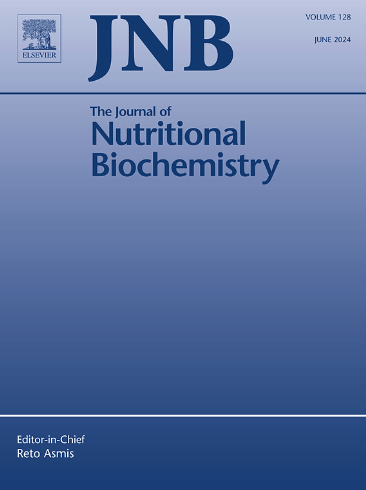Mitochondrial fatty acid oxidation dysfunction impairs autophagic flux through ATP deficiency-caused lysosomal pH abnormity
IF 4.8
2区 医学
Q1 BIOCHEMISTRY & MOLECULAR BIOLOGY
引用次数: 0
Abstract
Autophagy, a pivotal lysosomal degradation process, plays crucial roles in cellular homeostasis and energy metabolism. Mitochondrial fatty acid oxidation (FAO), a key mitochondrial function, is crucial for energy production. Generally, mitochondrial dysfunction exerts negative effects on autophagy, but the regulatory role of mitochondrial FAO dysfunction on the autophagic process remains unclear. The present study aimed to elucidate the role and mechanism of mitochondrial FAO in regulating autophagy process. We used Nile tilapia (Oreochromis niloticus) as a model and inhibited mitochondrial FAO by dietary mildronate feeding or knocking down carnitine palmitoyl transferase 1a. We found that mitochondrial FAO inhibition enhanced autophagy initiation and lysosomal proliferation accompanied by decreased autophagy degradation activity due to lysosomal acidification abnormity. Moreover, mitochondrial FAO inhibition decreased adenosine triphosphate (ATP) production and elevated adenosine monophosphate (AMP)/ATP promoted autophagy initiation via the AMP-activated protein kinase‑serine/threonine kinase 1 pathway. Furthermore, mitochondrial FAO inhibition upregulated peroxisome proliferator-activated receptor alpha and retinoid X receptor alpha protein expression, which promoted transcription factor EB mRNA and its protein expression. Meanwhile, mitochondrial FAO inhibition led to lysosomal alkalinization, which is due to a pH increase caused by v-ATPase V1/V0 imbalance and ATP deficiency from mitochondrial dysfunction. Collectively, our results highlight the role of mitochondrial FAO in maintaining lysosomal homeostasis and autophagic flux through stabilizing lysosomal acidification.
线粒体脂肪酸氧化功能障碍通过ATP缺乏引起的溶酶体pH异常损害自噬通量。
自噬是一个关键的溶酶体降解过程,在细胞稳态和能量代谢中起着至关重要的作用。线粒体脂肪酸氧化是线粒体的一项关键功能,对能源生产至关重要。一般来说,线粒体功能障碍会对自噬产生负面影响,但线粒体FAO功能障碍对自噬过程的调节作用尚不清楚。本研究旨在阐明线粒体FAO在调节细胞自噬过程中的作用及其机制。我们以尼罗罗非鱼(Oreochromis niloticus)为模型,通过饮食中喂食米膦酸盐或敲低肉碱棕榈酰基转移酶1a来抑制线粒体FAO。我们发现,线粒体FAO抑制增强了自噬起始和溶酶体增殖,同时由于溶酶体酸化异常导致自噬降解活性降低。此外,线粒体FAO抑制降低了三磷酸腺苷(ATP)的产生,升高的单磷酸腺苷(AMP)/ATP通过AMP激活的蛋白激酶-丝氨酸/苏氨酸激酶1途径促进了自噬的启动。此外,线粒体FAO抑制上调过氧化物酶体增殖体激活受体α和类视黄醇X受体α蛋白的表达,从而促进转录因子EB mRNA及其蛋白的表达。同时,线粒体FAO抑制导致溶酶体碱化,这是由于v-ATP酶V1/V0失衡引起的pH升高和线粒体功能障碍引起的ATP缺乏。总的来说,我们的研究结果强调了线粒体FAO通过稳定溶酶体酸化来维持溶酶体稳态和自噬通量的作用。
本文章由计算机程序翻译,如有差异,请以英文原文为准。
求助全文
约1分钟内获得全文
求助全文
来源期刊

Journal of Nutritional Biochemistry
医学-生化与分子生物学
CiteScore
9.50
自引率
3.60%
发文量
237
审稿时长
68 days
期刊介绍:
Devoted to advancements in nutritional sciences, The Journal of Nutritional Biochemistry presents experimental nutrition research as it relates to: biochemistry, molecular biology, toxicology, or physiology.
Rigorous reviews by an international editorial board of distinguished scientists ensure publication of the most current and key research being conducted in nutrition at the cellular, animal and human level. In addition to its monthly features of critical reviews and research articles, The Journal of Nutritional Biochemistry also periodically publishes emerging issues, experimental methods, and other types of articles.
 求助内容:
求助内容: 应助结果提醒方式:
应助结果提醒方式:


